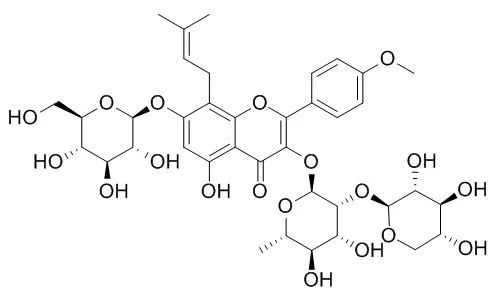| Description: |
Epimedin A,epimendin B, epimendin C, icariin and baohuoside are flavonoids, main active ingredient in Epimedium, have clear anti-osteoporosis effect, the accumulation of epimedins A, B, C, and icariin in a traditional medicinal plant could be suppressed by light stress. |
| In vitro: |
| Acta Physiol Plant, 2013, 35(11):3271-5. | | Light stress suppresses the accumulation of epimedins A, B, C, and icariin in Epimedium, a traditional medicinal plant.[Reference: WebLink] | Epimedium is well-known in China and East Asia due to high content of flavonoid derivatives, including icariin, epimedin A, Epimedin B, and epimedin C, hereafter designated as bioactive components, which have been extensively utilized to cure many diseases. So far, the molecular mechanism of the bioactive components biosynthesis remains unclear.
METHODS AND RESULTS:
In the present study, the effect of light stress (24 h illumination) on the accumulation of bioactive components and the expression of flavonoid genes in Epimedium was investigated. Under light stress, the structural genes CHS1, CHI1, F3H, FLS, DFR1, DFR2, and ANS were remarkably up-regulated while CHS2 and F3′H were significantly down-regulated. For transcription factors, the expression of Epimedium MYB7 and TT8 were increased while Epimedium GL3, MYBF, and TTG1 expression were depressed. Additionally, the content of bioactive components was significantly decreased under light stress.
CONCLUSIONS:
Our results suggested that the decrease of bioactive compounds may be attributed to transcripts of late genes (DFRs and ANS) increased to a higher level than that of early genes (FLS and CHS1). | | Drug Metab Dispos . 2015 Aug;43(8):1181-9. | | Ginsenosides Regulate PXR/NF-κB Signaling and Attenuate Dextran Sulfate Sodium-Induced Colitis[Pubmed: 25986850] | | Abstract
Pregnane X receptor (PXR) activation exhibits anti-inflammatory effects via repressing nuclear factor-κB (NF-κB); however, its overactivation may disrupt homeostasis of various enzymes and transporters. Here we found that ginsenosides restore PXR/NF-κB signaling in inflamed conditions without disrupting PXR function in normal conditions. The effects and mechanisms of ginsenosides in regulating PXR/NF-κB signals were determined both in vitro and in vivo. Ginsenosides significantly inhibited NF-κB activation and restored the expression of PXR target genes in tumor necrosis factor-α-stimulated LS174T cells. Despite not being PXR agonists, ginsenosides repressed NF-κB activation in a PXR-dependent manner. Ginsenosides significantly increased the physical association between PXR and the NF-κB p65 subunit and thereby decreased the nuclear translocation of p65. Ginsenoside Rb1 and compound K (CK) were major bioactive compounds in the regulating PXR/NF-κB signaling. Consistently, ginsenosides significantly attenuated dextran sulfate sodium-induced experimental colitis, which was associated with restored PXR/NF-κB signaling. This study indicates that ginsenosides may elicit anti-inflammatory effects via targeting PXR/NF-κB interaction without disrupting PXR function in healthy conditions. Ginsenoside Rb1 and CK may serve as leading compounds in the discovery of new drugs that target PXR/NF-κB interaction in therapy for inflammatory bowel disease.
Copyright © 2015 by The American Society for Pharmacology and Experimental Therapeutics. |
|
| In vivo: |
| Oxid Med Cell Longev . 2015;2015:843721. | | Ginsenoside Rb1 Treatment Attenuates Pulmonary Inflammatory Cytokine Release and Tissue Injury following Intestinal Ischemia Reperfusion Injury in Mice[Pubmed: 26161243] | | Abstract
Objective. Intestinal ischemia reperfusion (II/R) injury plays a critical role in remote organ dysfunction, such as lung injury, which is associated with nuclear factor erythroid 2-related factor 2 (Nrf2)/heme oxygenase-1 (HO-1) signaling pathway. In the present study, we tested whether ginsenoside Rb1 attenuated II/R induced lung injury by Nrf2/HO-1 pathway. Methods. II/R injury was induced in male C57BL/6J mice by 45 min of superior mesenteric artery (SMA) occlusion followed by 2 hours of reperfusion. Ginsenoside Rb1 was administrated prior to reperfusion with or without ATRA (all-transretinoic acid, the inhibitor of Nrf2/ARE signaling pathway) administration before II/R. Results. II/R induced lung histological injury, which is accompanied with increased levels of malondialdehyde (MDA), interleukin- (IL-) 6, and tumor necrosis factor- (TNF-) α but decreased levels of superoxide dismutase (SOD) and IL-10 in the lung tissues. Ginsenoside Rb1 reduced lung histological injury and the levels of TNF-α and MDA, as well as wet/dry weight ratio. Interestingly, the increased Nrf2 and HO-1 expression induced by II/R in the lung tissues was promoted by ginsenoside Rb1 treatment. All these changes could be inhibited or prevented by ATRA. Conclusion. Ginsenoside Rb1 is capable of ameliorating II/R induced lung injuries by activating Nrf2/HO-1 pathway. |
|






 Cell. 2018 Jan 11;172(1-2):249-261.e12. doi: 10.1016/j.cell.2017.12.019.IF=36.216(2019)
Cell. 2018 Jan 11;172(1-2):249-261.e12. doi: 10.1016/j.cell.2017.12.019.IF=36.216(2019) Cell Metab. 2020 Mar 3;31(3):534-548.e5. doi: 10.1016/j.cmet.2020.01.002.IF=22.415(2019)
Cell Metab. 2020 Mar 3;31(3):534-548.e5. doi: 10.1016/j.cmet.2020.01.002.IF=22.415(2019) Mol Cell. 2017 Nov 16;68(4):673-685.e6. doi: 10.1016/j.molcel.2017.10.022.IF=14.548(2019)
Mol Cell. 2017 Nov 16;68(4):673-685.e6. doi: 10.1016/j.molcel.2017.10.022.IF=14.548(2019)